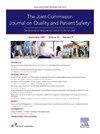Enhancing Clinical Guideline Adherence in Diabetic Foot Ulcer Prevention: A Case Study on Quality Improvement Interventions
IF 2.4
Q2 HEALTH CARE SCIENCES & SERVICES
Joint Commission journal on quality and patient safety
Pub Date : 2025-06-22
DOI:10.1016/j.jcjq.2025.06.011
引用次数: 0
Abstract
Background
Diabetic foot ulcers (DFUs) are common and serious complications in diabetes. To avoid DFUs, identification of at-risk patients through a structured foot assessment leading to appropriate risk classification is essential. However, this is often lacking in clinical practice. This study aimed to identify barriers and facilitators to guideline adherence in diabetic care and to increase the proportion of diabetic patients who receive a foot risk classification.
Methods
This quantitative evaluation of improvement interventions was conducted at a department of prosthetics and orthotics (DPO) in the south of Sweden. To identify barriers and facilitators to guideline adherence and identify potential interventions, the authors used the COM-B (Capability, Opportunity, Motivation, and Behaviour) framework and qualitative interviews designed as one pilot interview and two focus group sessions with practitioners at the DPO. To improve guideline adherence, the research team implemented several interventions targeting behaviour over multiple Plan-Do-Study-Act cycles where training, education, and easily accessible material were incorporated. Eligible patients at risk of DFUs were identified by means of their medical journal. The candidates were referred to the DPO to be provided with preventive offloading devices.
Results
The frequency of patients receiving a foot examination and risk classification increased from 32.0% to 61.9%. Practitioners described the perception of increased patient safety as a facilitator of adherence to the clinical guidelines, while time limitation and insufficient knowledge were perceived as barriers.
Conclusion
To ease implementation of evidence-based guidelines in diabetes, clinics must address behavioural mechanisms related to adherence. The result adds further knowledge about enablers and barriers in clinical practice. Future research should focus on the clinical outcomes of improvement efforts in diabetes care in DPOs to avoid DFUs.
加强糖尿病足溃疡预防的临床指南依从性:质量改善干预措施的案例研究。
背景:糖尿病足溃疡(DFUs)是糖尿病常见且严重的并发症。为了避免dfu,通过结构化的足部评估来识别高危患者,从而进行适当的风险分类是至关重要的。然而,这在临床实践中往往缺乏。本研究旨在确定糖尿病护理依从指南的障碍和促进因素,并增加接受足部风险分类的糖尿病患者的比例。方法:改进干预措施的定量评估是在瑞典南部的假肢和矫形(DPO)部门进行的。为了确定遵守指南的障碍和促进因素,并确定潜在的干预措施,作者使用了COM-B(能力、机会、动机和行为)框架和定性访谈,设计为一次试点访谈和两次与DPO从业者的焦点小组会议。为了提高指南的依从性,研究小组在多个计划-执行-研究-行动周期中实施了针对行为的几种干预措施,其中包括培训、教育和易于获取的材料。通过他们的医学杂志确定有DFUs风险的合格患者。候选人被提交给政治事务厅,由其提供预防性卸载装置。结果:患者接受足部检查和风险分类的频率从32.0%增加到61.9%。从业人员认为,患者安全性的提高是遵守临床指南的促进因素,而时间限制和知识不足被认为是障碍。结论:为了便于在糖尿病中实施循证指南,诊所必须解决与依从性相关的行为机制。该结果进一步增加了对临床实践中促成因素和障碍的了解。未来的研究应侧重于改善DPOs患者糖尿病护理的临床结果,以避免dfu。
本文章由计算机程序翻译,如有差异,请以英文原文为准。
求助全文
约1分钟内获得全文
求助全文
来源期刊

Joint Commission journal on quality and patient safety
HEALTH CARE SCIENCES & SERVICES-
CiteScore
3.80
自引率
4.30%
发文量
116
审稿时长
49 days
 求助内容:
求助内容: 应助结果提醒方式:
应助结果提醒方式:


